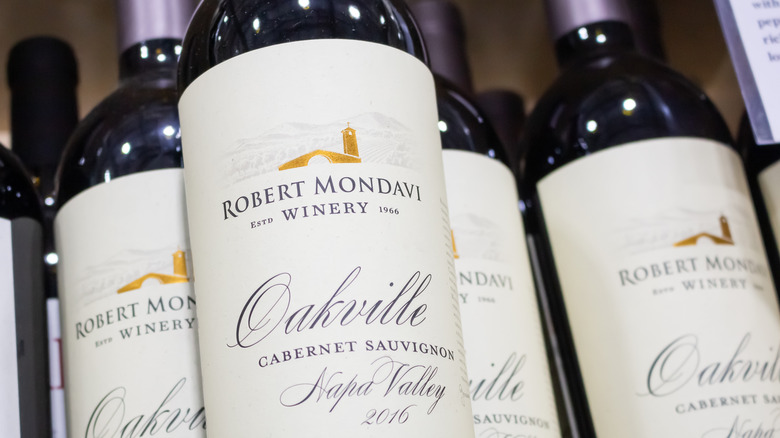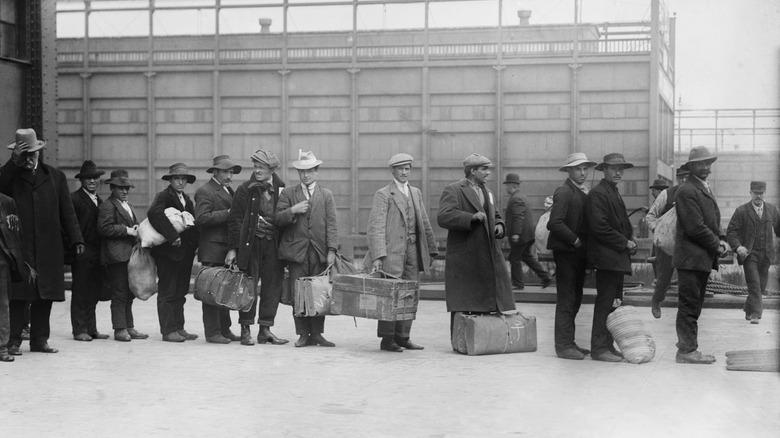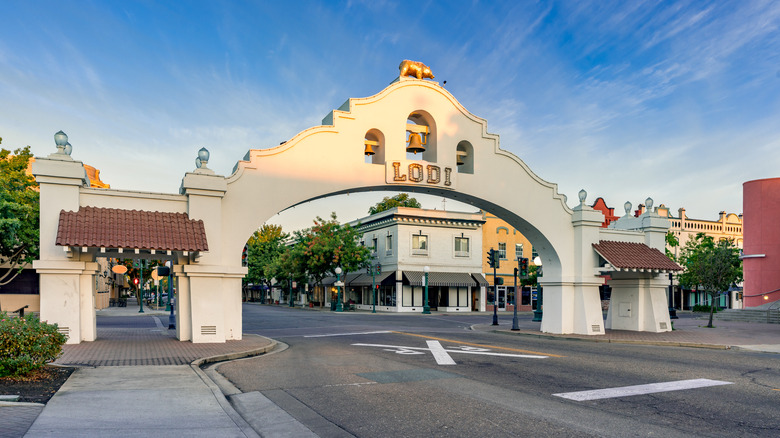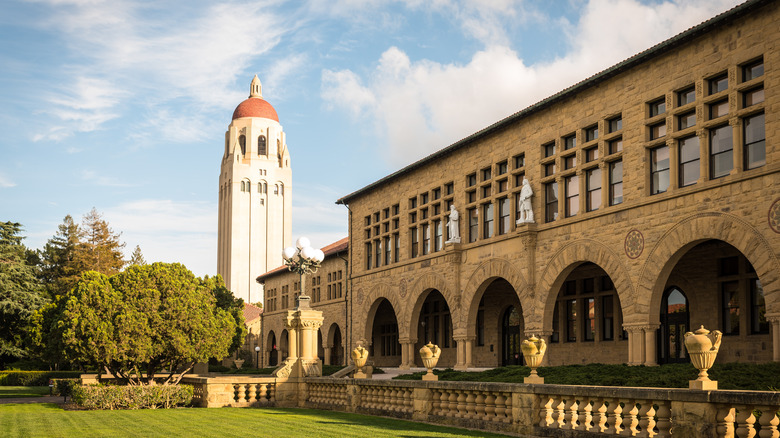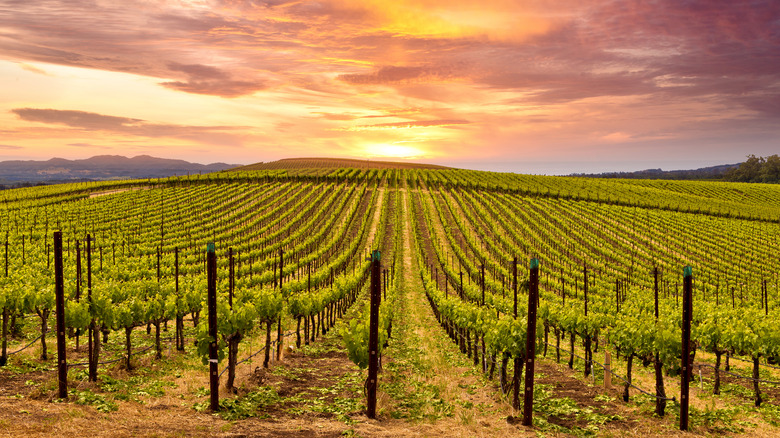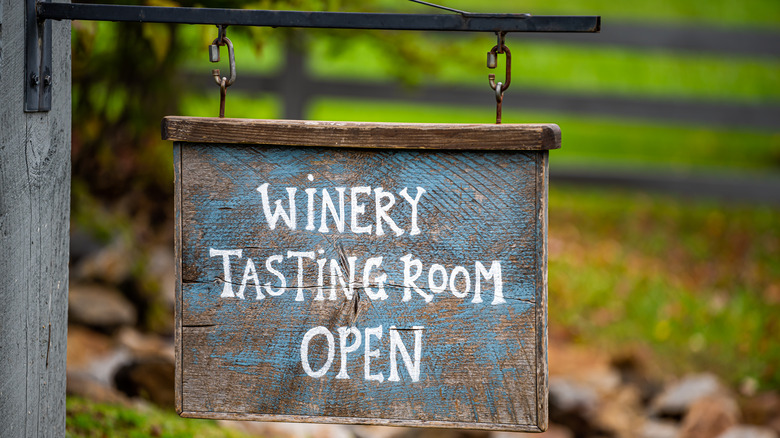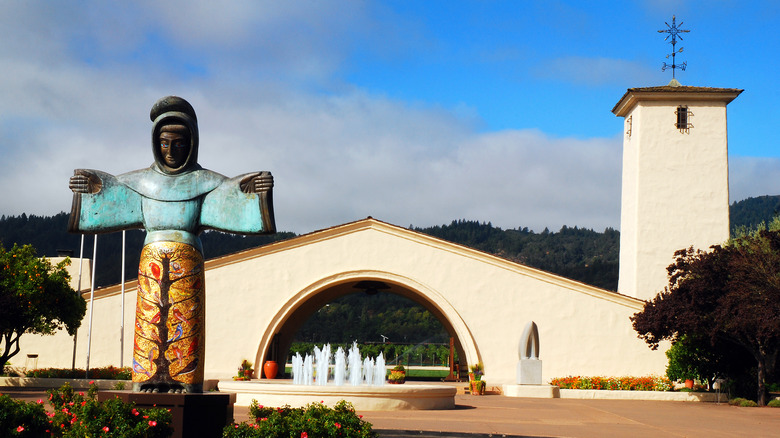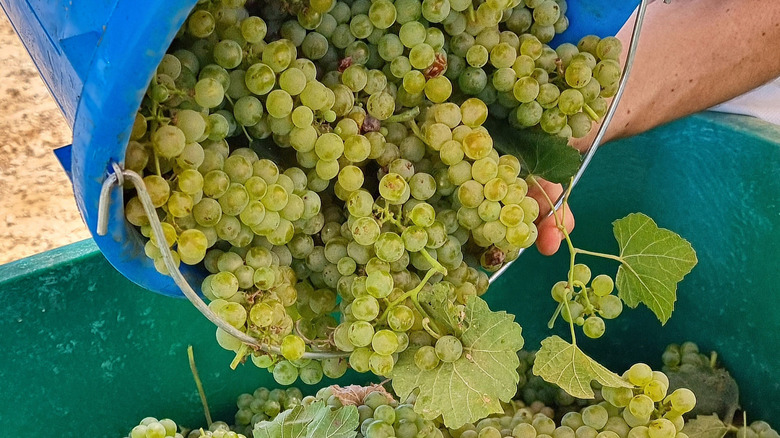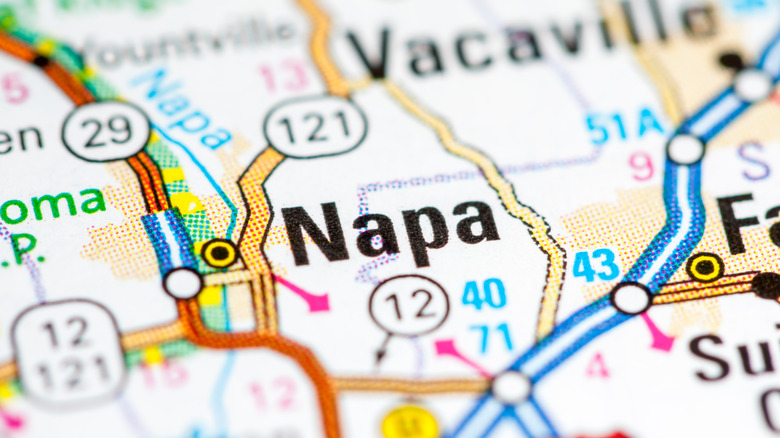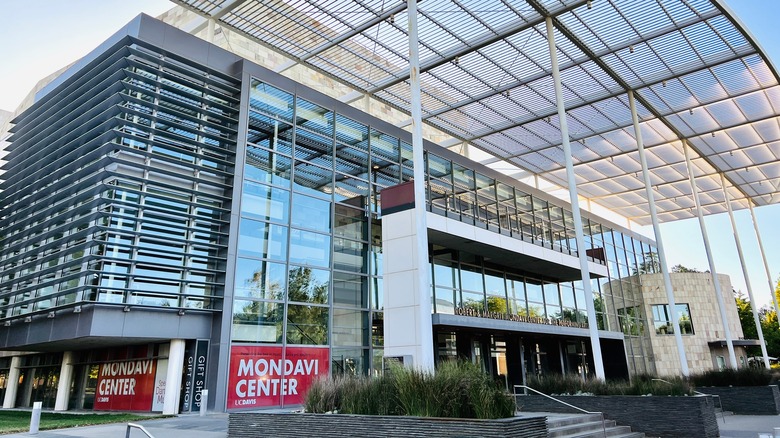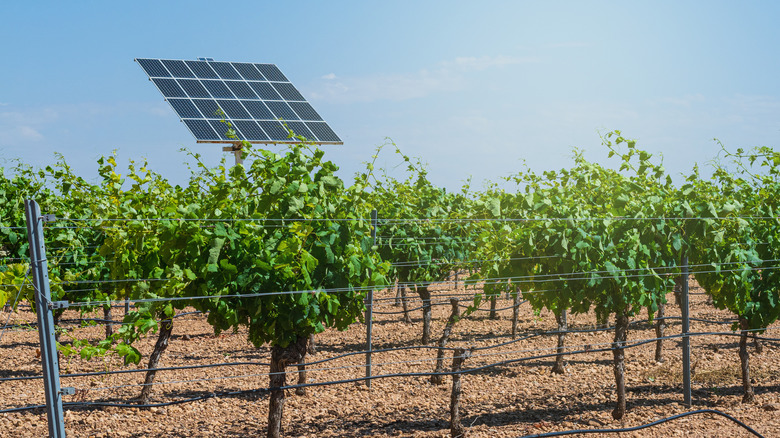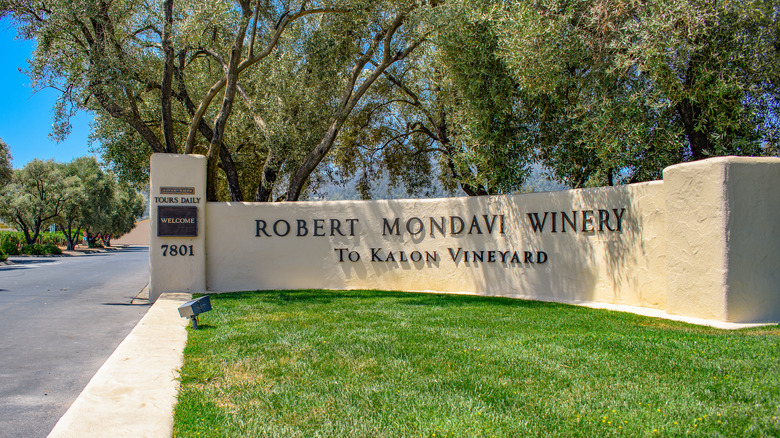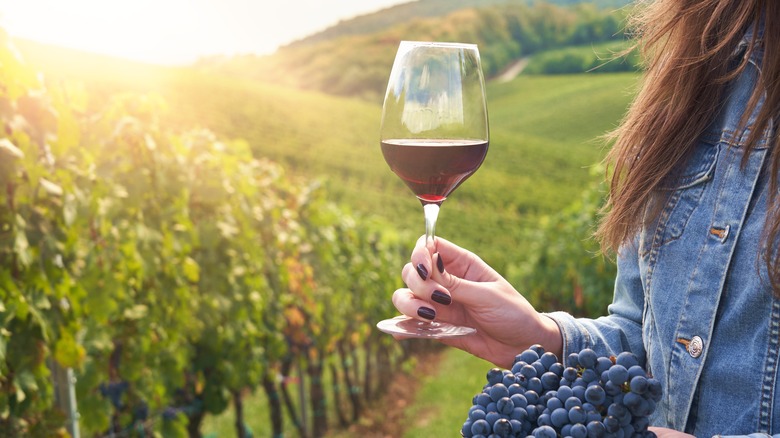The Untold Truth Of Robert Mondavi Wines
The epic tale of Robert Mondavi Wines is one that has continued for nearly a century. It's chock-full of family drama, unprecedented achievements, and historical milestones in winemaking, all of which have been set against the backdrop of one immigrant family: the Mondavis.
Renowned for putting Napa Valley on the international viticulture map, as well as bringing high-quality, low-cost wine to dinner tables across the world, the Robert Mondavi label is nothing short of legendary, as is the namesake winemaker himself, per Entrepreneur. Some of his most notable contributions to winemaking in Napa Valley include establishing the first winery post-prohibition, using stainless steel barrels, branding the world-renowned fumé blanc, pioneering environmental stewardship in vineyard farming practices throughout California, and establishing the UC Davis Robert Mondavi Institute for Wine and Food Science.
If you happened to have read "The House of Mondavi: The Rise and Fall of an American Wine Dynasty," a 400-plus-page saga by Julia Flynn Siler, you may know most of what there is to know about Robert Mondavi wines, but in case you haven't or need a refresher, we've rounded up some important pieces of the dramatic story for you to indulge in.
The Mondavi family emigrated from Italy to Minnesota in 1906
Like so many immigrant stories in the U.S., Cesare Mondavi's journey to America began with a dangerous crossing of the Atlantic Ocean from Italy to Ellis Island, after which he traveled to an iron-mining town in Minnesota (via "The House of Mondavi: The Rise and Fall of an American Wine Dynasty"). Cesare returned to his childhood home in Italy in 1908 to court his future wife, Rosa, whom he wed in November that same year.
The newlyweds promptly made the transatlantic traverse back to America, where Cesare returned to work in the mines alongside his brother in the hopes of building a better life for his family, according to Wine Enthusiast. Tragedy struck when Cesare's brother died in a mining accident, prompting Cesare to leave the mining industry and open a small grocery store. After some success, he sold his portion of the store to purchase a saloon that catered to Italian immigrants. Meanwhile, Rosa opened their modest home in Minnesota as a boardinghouse for other immigrant miners in order to supplement the family's income.
The Mondavi family moved to California in 1923
According to La Gazzetta Italiana, prohibition forced Cesare to close his saloon in 1919. However, under the Volstead Act, Congress permitted families to make batches of wine for personal use. As part of a local Italian-only members club, Cesare was selected to venture out west to California to purchase grapes on the club's behalf. On a trip to Lodi in California's Central Valley, Cesare recognized the peace and prosperity he could obtain for his family there and decided to relocate them from Minnesota to Lodi in 1923.
Traveling by train, the Mondavis settled in the agricultural town and immediately began shipping grapes back to Minnesota and other parts of the U.S. where Italian friends and family had emigrated. The Mondavi home in Lodi also became a home base for immigrants migrating from Italy to the U.S., and the family became known for their hospitality. When Cesare's sons, Robert and Peter, were off from school during the summer months, they would spend their time helping their father with fruit shipments, marking the beginning of the family's wine dynasty.
Robert Mondavi attended Stanford University
According to "The House of Mondavi: The Rise and Fall of an American Wine Dynasty," when the Great Depression began in 1929, Cesare Mondavi found himself strapped for cash and had to ask his sons to give him back the $15,000 he had paid them to help with the family business. In exchange, Cesare promised to send his sons to their college of choice, and both Peter and Robert chose to attend Stanford University.
During his time at Stanford, Robert played on the rugby team while studying business and economics. During his senior year, under the direction of his father, Robert enrolled in a chemistry course in the hopes it would help him learn how to make wine. The first member of the Mondavi family to graduate from college, Robert earned his degree from Stanford in 1936 and then promptly enrolled in viticulture classes at the University of California at Berkeley.
In 1943, the Mondavis purchased Charles Krug Winery
When Robert heard about the potential sale of Charles Krug Winery in 1943, he jumped at the opportunity to purchase Napa Valley's oldest winery, but he didn't have the funds to invest in this new business venture on his own, so he convinced his father to make the purchase on behalf of the family (via Wine Spectator). According to The Wine Cellar Insider, Cesare and Rosa agreed to purchase the winery for $75,000 per the request of their oldest son.
After Cesare's death in 1959, his wife, Rosa, became the president of Charles Krug wines, and alongside her sons Peter and Robert, they grew the winery to become one of the most well-known wineries in California in the 1960s. However, family tensions grew between the brothers, and after a 1965 fistfight, Robert sued for his share in the Charles Krug estate. By 1976, the decade-long battle over the family's first winery came to an end with Peter gaining full ownership of the Charles Krug name and Robert obtaining the majority of the vineyards associated with Charles Krug wines.
The Mondavi brothers had an epic family feud
Peter and Robert Mondavi were known for their different styles of management as well as differences in their personalities (per La Gazzetta Italiana). More outspoken and assertive, Robert was more focused on promoting the family's Charles Krug wines, while Peter, who was more conventional and quiet, thought their efforts should center around production. Their personality differences took a turn for the worse in 1965 during a visit to Lodi when the brothers began to argue over Robert's lavish spending habits on the company's dime (via "The House of Mondavi: The Rise and Fall of an American Wine Dynasty").
The conflict between them had been escalating for some time, and after the fight came to blows, the brothers sought legal counsel to settle the score. The majority of shareholders in the company had decided that Peter should become the general manager of Charles Krug, with Robert taking a back seat. The decision did not sit well with Robert, who continued to battle with his opposing family members. Ultimately, the eldest son of Cesare and Rosa was fired from the family business, leading him to open the Robert Mondavi Winery in 1966.
Robert Mondavi Winery was the first to open after prohibition
The Washington Post reported that the grand opening of the Robert Mondavi Winery in 1966 marked the opening of the first major winery in Napa Valley's up-and-coming town of Oakville after prohibition. Following the establishment of the 18th Amendment, wineries across California were forced to close or adapt by growing other agricultural goods besides grapes, according to ABC Fine Wine & Spirits.
The only wineries left standing in the wake of prohibition were bootleggers and underground producers, while many of the larger wineries had been forced to close their doors. The Charles Krug estate was one of the only wineries that survived prohibition after being sold to the Mondavi family in 1943. It wasn't until 1966 when Robert Mondavi put Napa Valley back on the map by opening his own winery. It was a monumental move for the family and for Napa Valley as a whole, and it marked a turning point for California's wine industry.
The Robert Mondavi Winery is located in the heart of Napa Valley
Located in Oakville, California off of route 29 in the heart of Napa Valley, the Robert Mondavi Winery is situated next to the famous To Kalon vineyard and was designed by architect Cliff May (per Wine Enthusiast). Considered revolutionary at the time due to its visitor-friendly layout, the winery design was intended to accommodate the public and allow outsiders to explore the winemaking process during harvest season and taste the wines throughout the year.
The bell tower, grand archway, and mission-style architecture made Robert Mondavi Winery one of the most recognizable wineries in Napa and served as the inspiration behind the label design, which features an iconic image of the property. The graphic designer, Mallette Dean, also added a few poplar trees around the winery to frame it on the label. The winery eventually planted real poplars to mimic the image Dean had already brought to life. Located approximately five miles south of Charles Krug Winery, Robert Mondavi Winery is considered one of the most photographed wineries in Napa Valley (per Napa Wine Project).
Robert Mondavi created fumé blanc
After opening his winery in 1966, Robert Mondavi put his world-renowned winemaking skills to the test by barrel-aging his sauvignon blanc to create a drier white wine, which he aptly coined fumé blanc. At the time, sauvignon blanc was known for being a less desirable, sweet table wine that wasn't winning any awards, according to Forbes. With his taste for dry white French wines, Robert Mondavi wanted to elevate the sauvignon blanc in the hopes of pairing it better with food to meet consumer demands. Using sauvignon blanc grapes, Mondavi changed the way they were produced by aging them in oak barrels using dry fermentation (via Wine.com). Drawing inspiration from the Pouilly-Fumé region in France's Loire Valley, Mondavi then renamed the varietal to reflect his innovative process, and so fumé blanc was born.
The Robert Mondavi Winery now offers four different vintages of fumé blanc using grapes from an Oakville vineyard and from To Kalon, its most famous vineyard. The varietal pairs well with chicken, seafood, and spicy dishes, and boasts notes of lemon, grapefruit, exotic pineapple, and grass.
Mondavi wines put Napa Valley on the international map
According to UC Davis, establishing the winery was part of Robert's overall vision to pioneer winemaking techniques that would rival European wines. Alongside his wife, Margrit, Robert frequently traveled around the vineyards of France, Spain, and Italy (via La Gazzetta Italiana). His interest in winemakers on the world stage helped play a role in promoting Napa Valley overseas, as well as bringing groundbreaking techniques to California.
Outside of improving vineyard management and marketing standards, Robert also elevated wine production by using smaller oak barrels, incorporating stainless steel tanks in the manufacturing process, leaving grape skins on longer during fermentation, paying attention to soil and climate, and utilizing pneumatic presses for a more gentle crush. The changes he brought to the region's winemakers helped elevate Napa Valley wines and change the way they were perceived around the world. Within a few years of opening the Robert Mondavi Winery, he was among the first winemakers to export premium California wine outside the United States.
UC Davis partnered with Robert Mondavi to create a winemaking program
In 2001, just three years before selling his namesake winery, Robert and his wife donated $35 million to the UC Davis College of Agriculture and Environmental Science to help fund a wine and food institute and a performing arts center (per UC Davis). The establishment of the Robert Mondavi Institute for Wine and Food Science represents the largest private contribution to UC Davis by an individual donor in the history of the University of California.
The donation is being supplemented by private contributions and other campus funds to establish a groundbreaking viticulture, enology, and food science research and teaching facility. The state-of-the-art department boasts over 100,000 square feet of new space housing the largest and most innovative academic program of its kind in the world. The partnership is, at its core, a homage to all the winemaking research Mondavi studied at UC Davis throughout his career, which he believed far surpassed the level of Europe's winemaking knowledge.
Robert Mondavi is a Napa Green Certified winery
The Robert Mondavi Winery is not only green in the grass and vineyards, but in the way it produces wine, as well as its commercial operations. In partnership with the Napa County Resource Conservation District, the team at Robert Mondavi created the Napa Sustainable Winegrowing Group, which helps educate other winemakers in the region on environmental standards like irrigation, drought, pest management, erosion control and water quality improvement and conservation. It's also revered as the first winery to receive an Innovator Award from California's Environmental Protection Agency.
As a Napa Green Farm Certified winery, Robert Mondavi Winery cooperates with other farmers and environments to improve restoration projects, support sustainable farming techniques, and take meaningful action to promote the region's environmental stewardship. According to Nuvo Magazine, the incentive program is more than just a gold star in sustainable winemaking, as it also includes recycling, reducing a winery's carbon footprint, improving employment equity, and raising the standards for health care, salary, and job stability.
Robert Mondavi Winery sold for $1.3 billion in 2004
In November 2004, SFGate reported that Robert Mondavi sold his namesake winery for $1.3 billion to the world's largest product goods company in the United States, Constellation Brands. The deal was made to ultimately prevent the world-renowned winery from dividing and selling off the company in pieces, as Robert Mondavi Corp. had reportedly been facing financial deficits for years, per Wine Spectator. From family feuds to financial woes, the company had reportedly been on an economic rollercoaster for decades. Constellation Brands, which also owns a slew of major beverage powerhouses like Corona Extra, Modelo Especial, Kim Crawford, and Svedka Vodka to name a few, is responsible for all aspects of the company's marketing, production, distribution, and more.
In spite of the billion-dollar sale, then 91-year-old Robert Mondavi continued to act as a steward for his wines by serving as a brand ambassador and continuing to promote his wines at events and in the news.
The top winemakers at Robert Mondavi are now female
Following the billion-dollar sale of the Robert Mondavi wine empire, many top-tier positions within the winery were filled by new people. In 2018, Genevieve Janssens transitioned from Director of Winemaking to Chief Winemaker (via Wine Industry Advisor). The Morocco-born, France-raised winemaking legend has been managing vineyards around the world since 1977, per the company's about page. She even served as a lab enologist at Robert Mondavi Winery from 1978–1979, establishing her reputation as a female visionary within the Mondavi empire, as well as throughout the Napa Valley region.
In adhering to the standards set by the Napa Green Certification Council, which oversees gender equality in winery employment, female leadership at the winery has continued to grow. According to the San Francisco Chronicle, the Mondavi label acquired industry pioneer Sally Johnson Blum in July 2022 to serve as director of winemaking. Sally works alongside other female team winemakers, including Lauren Oliver, helping elevate the brand's reputation and quality.
